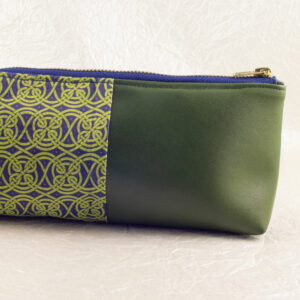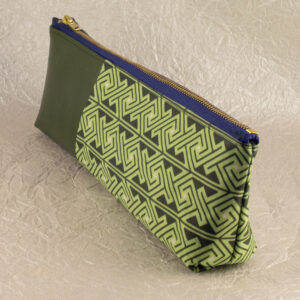Embossed Off-Center Celtic Spiral Print
An experiment for the OpenPress Project + Haus des Papers Rising Print exhibition: an embossed off-center Celtic spiral. I did this using a plate of glued-up laser-cut MDF pieces on a heavyweight Arches paper (probably Rives – I inherited a stack of it and don’t know for sure) using the OpenPress Project’s Postcard Printing Press.
As I went to print this, I discovered that a piece had separated from the finished plate and disappeared into the ambient studio mess. A 30 second power outage caused some kind of disaster for the local Internet provider, leaving me without service for 20 hours. Fortunately, I was able to move the Glowforge to the cellular network to cut a replacement piece, and attach it with CA glue.
The finest bits did not stand up to pressure very well, but the resulting prints are neat. I will be able to design better for a future attempt.
Here is a short of the printing/embossing process.
Celtic Art Washi Tape Origami Stars

My friend Georgie came up with a clever thing to do with some of my Celtic art washi tape. I gather a lot of people learned to make these origami “lucky stars” in grade school. They are new to me, but it was easy to learn. I stuck the tape to some scrap printer paper to make 11” strips, then folded them into stars. I sliced extra-wide Squared Spirals key pattern washi tape into three strips along the row lines. I haven’t done any with the knotwork washi tape yet as I didn’t think it would read, but I may try it eventually.
Celtic Art and Cactus Leather Pencil Pouches
I saw some pencil pouches somewhere, and knowing some people on their way back to school soon, I thought it would be fun to make some with the Celtic art fabric I designed and the eco-friendly cactus leather.
Making these has been educational, and has improved my sewing skills (though there is still plenty of room for more improvement). I learned both that I have a zipper foot for my Elna, and how to use it. I learned about boxed corners for bags.
All of the fabric is 100% cotton (organic, in the case of the Celtic art prints), and the Desserto cactus leather is made mostly from fast-growing, sustainably-harvestable nopal cactus, or from agave fiber that is waste from tequila production.
The pieces (fabric, cactus leather, and interfacing) were all cut on the laser cutter for optimal precision.
I printed my Evermore ambigram logo in silver on the linings with quick Ikonart photo screens.
The pouch design is adapted from one by Anna Graham of Noodlehead.
If you have a use for them, I made the Celtic art print fabrics available from Spoonflower.
I still have some stock of the Celtic art washi tapes seen in some of the photos, if you want some of that. Given the global war on small business, I am not sure when there will be more stock after what I have is gone.
Celtic Key Pattern Dice Vault

I was noticing that people were making dice using washi tape. They cast a “blank” (a smaller die with no numbers), wrap that in washi tape, then “shell” it by putting it in a larger mold of the same shape with numbers (and possibly a logo or other graphic). The first key pattern washi tape I made is pretty narrow (15mm). I wasn’t sure if it would work for that (spoiler: it turns out that, yes, it can work). I wanted to make other washi tape designs, including another key pattern. I made one of them extra wide (45mm).
A few dice makers are now using it to make dice! One of those, the wonderful Jessa at Silverleaf Dice, is celebrating hitting 2100 followers in Instagram with a big multi-artist giveaway. The theme is community inspiration, and she is making a set of dice with each of my washi tape designs.
I was thinking it would be fun to make a custom dice vault (a box sized to hold a set of dice) for those. I wondered about how I could echo the design elements of the washi tape on the vault. Watching a cosplay crafting video where someone was painting flex bond on EVA foam, I remembered that decoupage exists. After a couple quick tests, I determined that I could get the tape well adhered to wood with PVA wood glue and coat it with an appropriate sealer to get a nice finish.
This design adds some legs and a wood inlay lid with a different key pattern design.
There were a few small revisions as I built it. The first version of the legs had one part of the foot coming to a point. As I got to where I was ready to glue them on to the box body, I discovered that a point on one foot had chipped off. That made me realize it was probably too fragile, and I redesigned to make it less pointy and have a larger point of contact for the surface upon which it sits.
I primed the legs, but was not particularly careful or adequately slow and methodical with the metallic gold paint. I didn’t love the way they looked with the flaws. So, I made a new set and covered them with gold leaf. That was a lot more work than spray painting them, but they look great.
The spray version of the sealer for the gold leaf is just awful. It spits out in globs and makes an uneven mess. With a little fiddling, they still came out looking great. I got some of the brush-on variety for future projects.
The white oak and walnut key pattern inlaid lid is similar to some things I have done previously. I was surprised at how smoothly that went together.
The finished dice vault, paired with the matching set of washi tape dice, is going to one of the winners of the big Silverleaf Dice giveaway. If you are seeing this the first week of July 2025 and you have an Instagram account, go enter for a chance to win that or a number of other wonderful handmade TTRPG dice and accessories.
There is also an un-narrated 3.5-minute speed run video showing the process of making the dice vault:
Dragons Celtic Knotwork Compass Print
I have been wanting to design a Celtic art map compass that would be appropriate for fantasy maps. Entwined dragon bodies seemed like a good theme. The N-S axis is intended to be Gungnir, Odin’s spear from Norse mythology.
I made a laser-engraved rubber plate from my vector image, then printed on the new OpenPress Postcard Printing Press.
I made the print drying rack for an earlier printing project I haven’t gotten around to posting. It is a simple four-piece laser-cut design that comes apart for flat storage. I added the cutting files for the print drying rack to the Subscriber Archive as a free download, in case it is of use for anyone.
I made a 1-minute printing video:
Rechargeable Light-Up Icosahedron
I wanted one of the copper light-up icosahedra for the bookshelf in my office. I wanted to be able to leave it on to enjoy periodically without putting a bunch of the CR2032 coin cells in the landfill. I also wanted it to be easy to operate without using tools, and not super fragile.
After a fair amount of experimentation, I came up with this tiny 3D-printed light. It uses a rechargeable LIR1254 coin cell that can be easily removed (or swapped) for recharging in an external charger.
The bottom panel hinges open for access to the light. I used strips of foil made for EM shielding applications and tiny neodymium magnets to hold it closed.
I have been playing with it for a few days, and it seems to meet my design brief above. It runs for at least several hours on a charge (I haven’t yet exhausted a fully-charged battery with it).
I put the 3D model (STL) for the battery holder in the Archive for free download, in case it is of use to anyone. There is also a basic icosahedron pattern with the previous Small Polyhedra post.
There is a 3.5-minute video short walking through the design evolution and assembly.








































